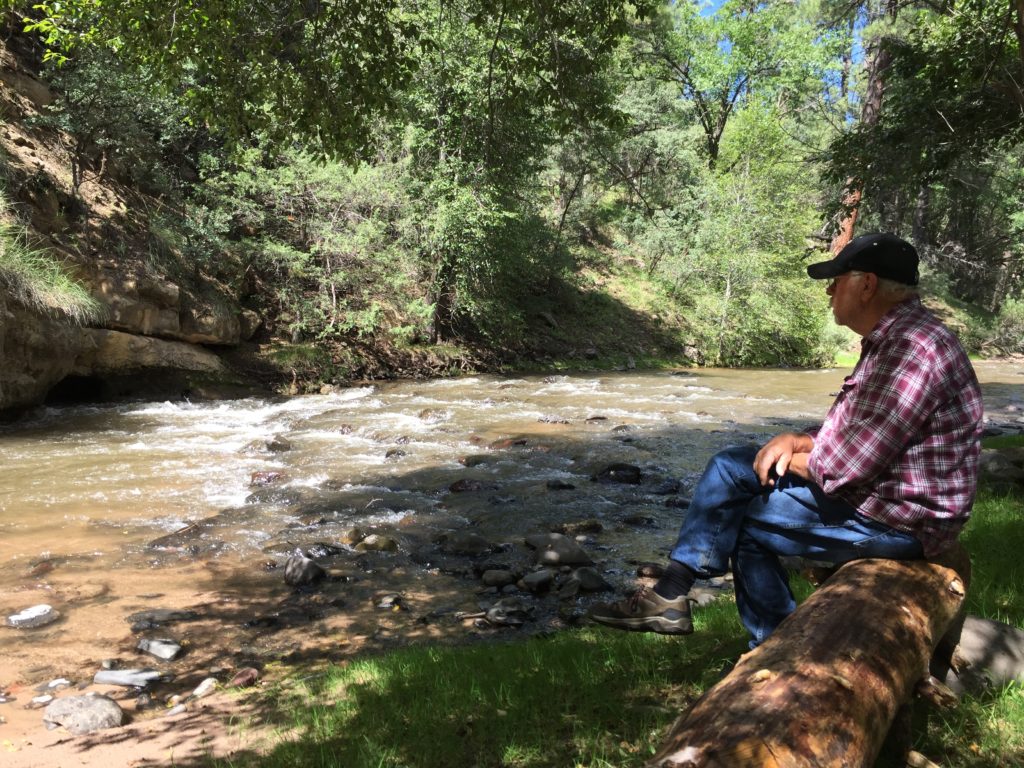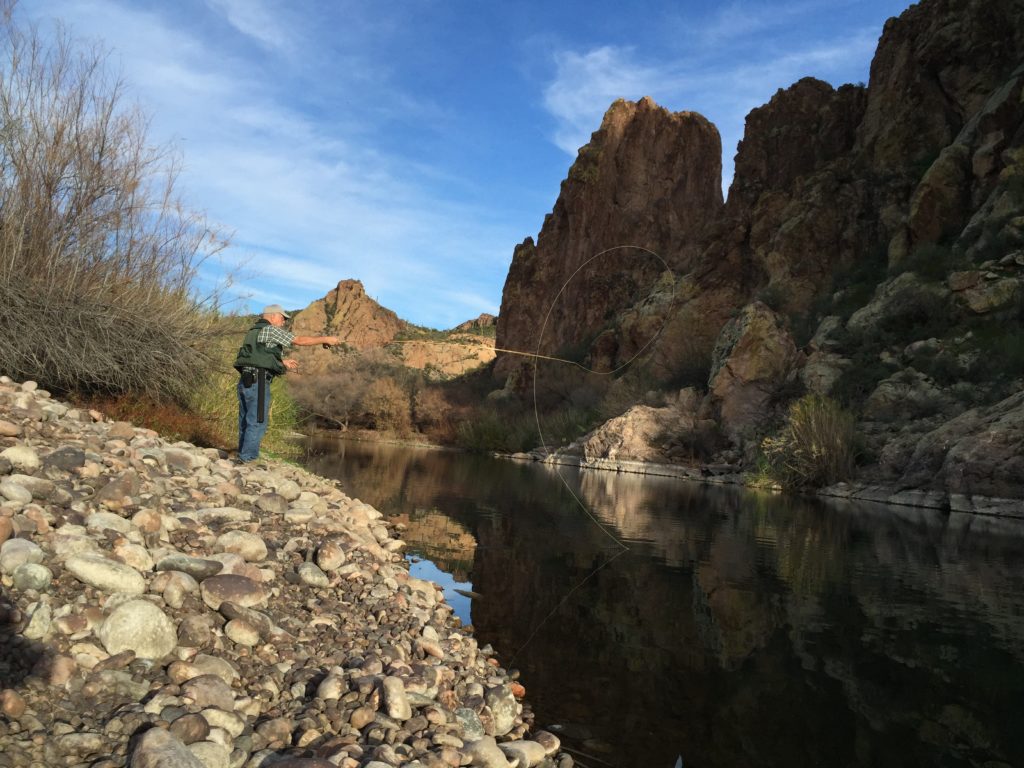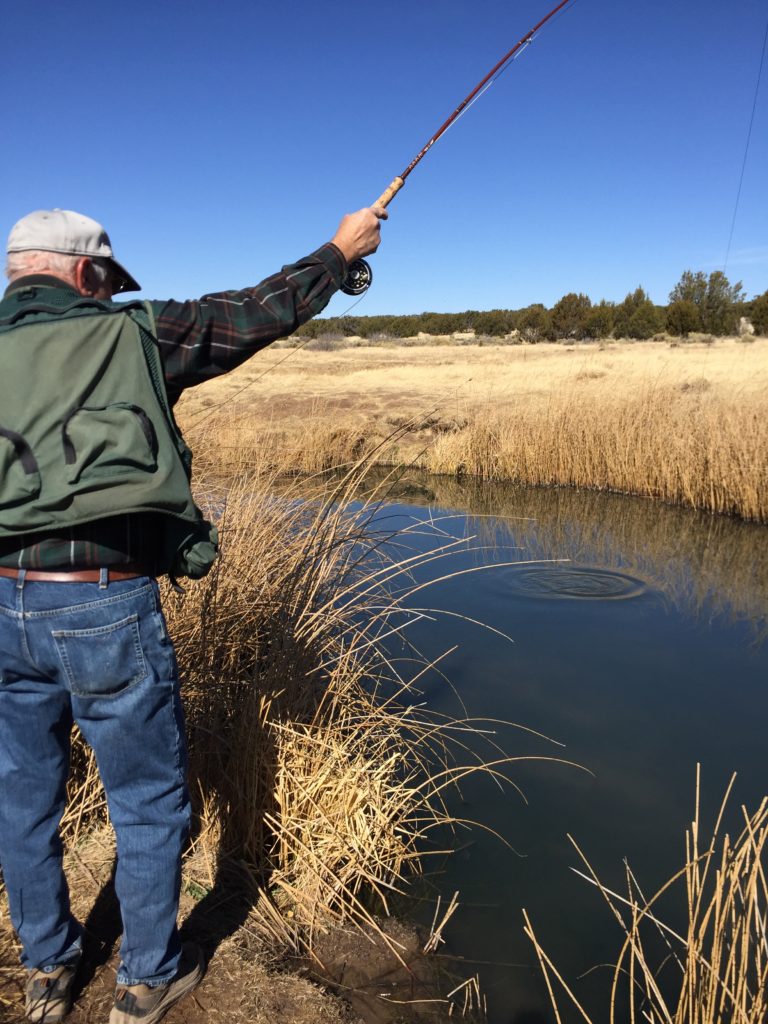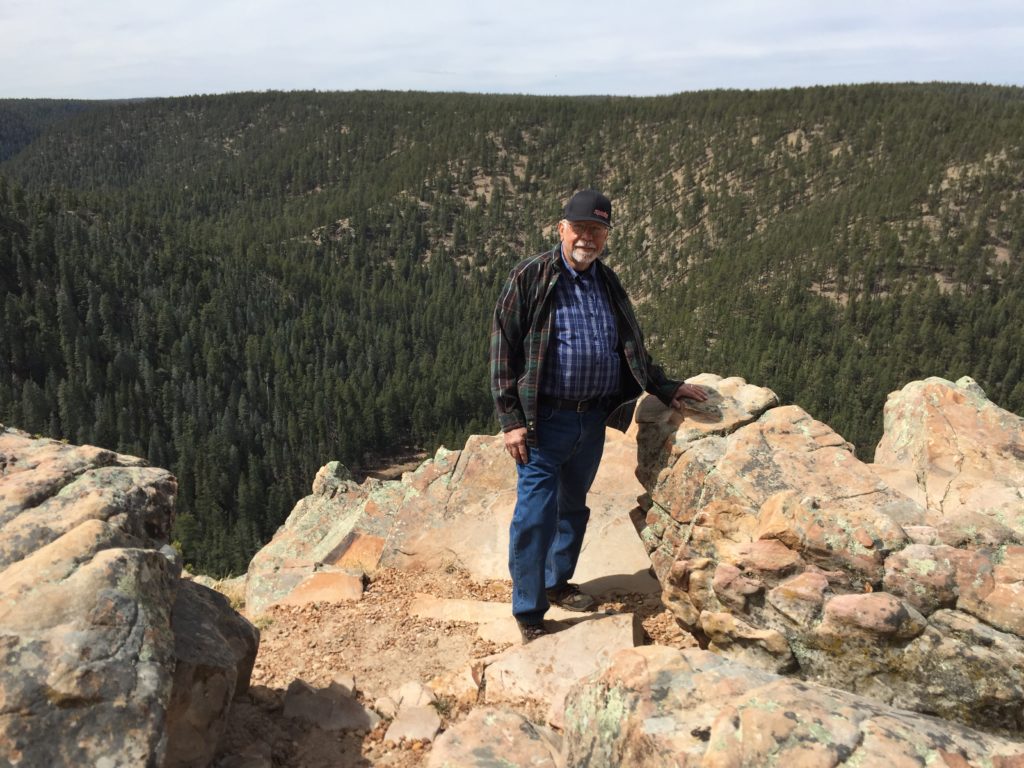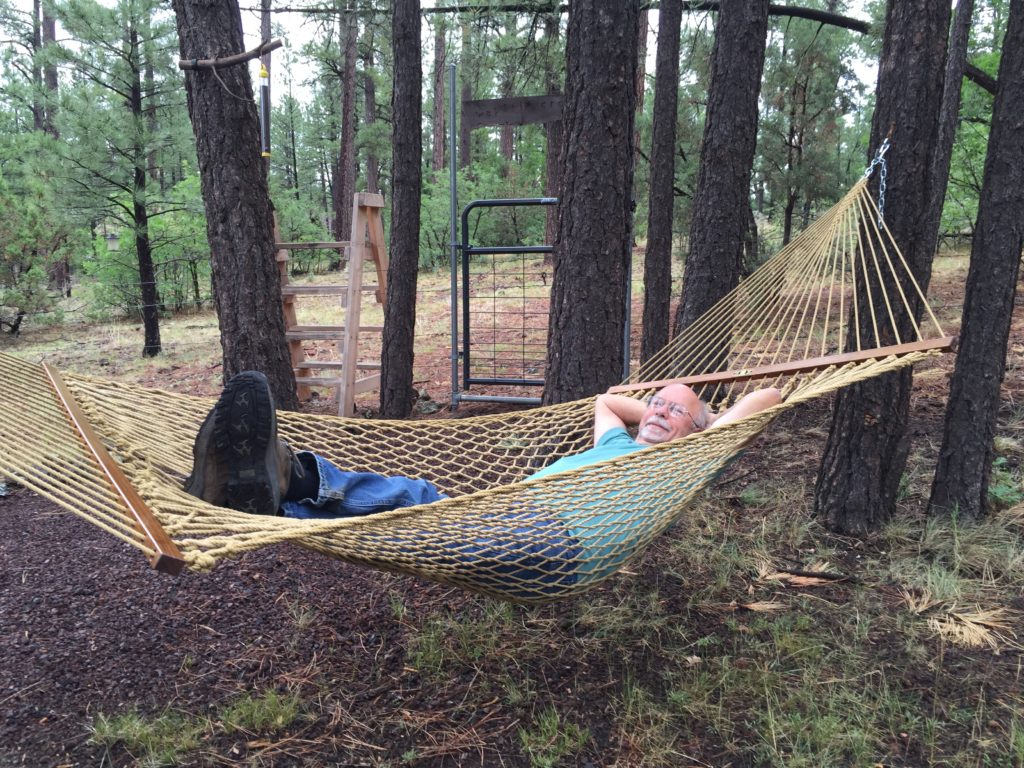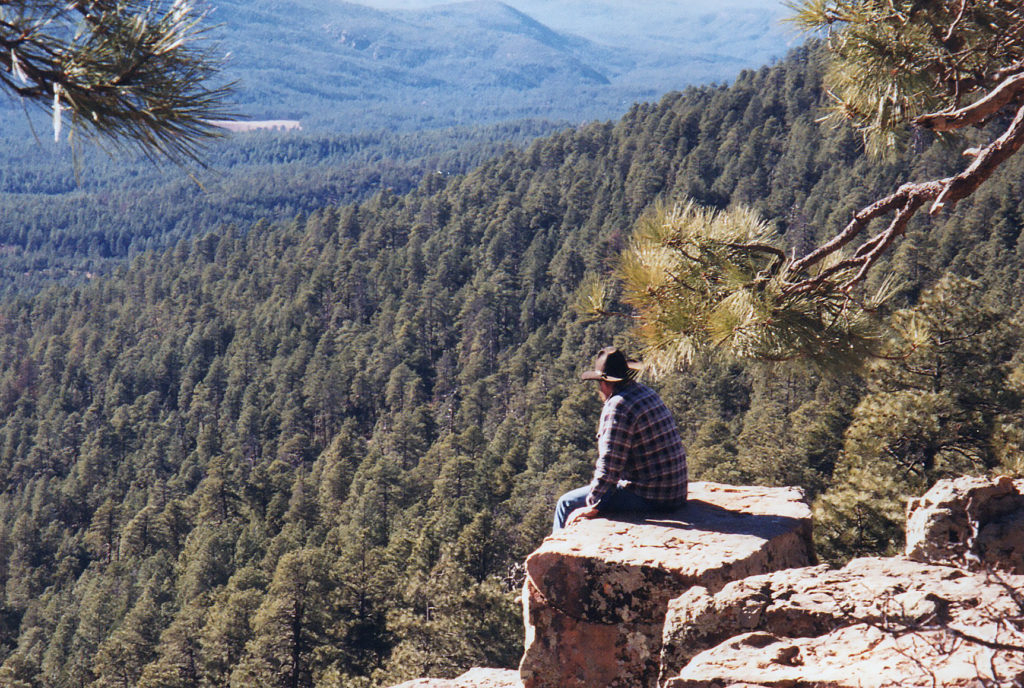For years my Dad had a good, old fashion station wagon for a family car and sport utility vehicle. There were a few four wheel drive automobiles around like the International Scout, International Crew Cab, Dodge Power Wagon, Jeep Jeepster, ford Bronco and a few others. But Dad’s station wagons served us well in getting us where we needed to go for the best hunting and fishing spots.
In 1964, Dad and one of his Condition Air Company partners, Paul Enginbritson, made a trip to San Diego to buy some Navy surplus equipment for their company. One of the items they targeted was a Navy Jeep that would be convenient to chase parts and have available for hunting and fishing jaunts. They were successful with the Jeep purchase and some other equipment for the shop.
Dad, one of his employees, Joe Savatone and my brother Rick, age 14, made a trip the following week to pick up the Jeep and equipment. They took the companies two ton Chevy stake bed truck to bring back the treasures. They loaded up their ditty bags and a large, shop made, galvanized ice chest in anticipation that they could find some time to do a little deep sea fishing while they were there and bring back some fresh seafood. Dad built this ice chest ten years earlier.
Well, as it turned out they did catch some Bonita and other salt water varieties and loaded up the ice chest with fish and as much ice as they could pack in for the long drive home. With the Jeep and other recently purposed equipment safely lashed down in the twenty foot long stake bed, they were off, heading back to Phoenix. They made it all the way to Indio without a hitch. Truck was running great. The two-forty air conditioning was working great, which is two open windows and forty miles per hour truck speed. Then came the hitch. It was more like a hitch hike which became necessary after they were pulled over by CHIP, or fondly known as California Highway Interstate Patrol, Just like the on the TV show, CHIP pulled Dad over to check all his documents like drivers license, truck registration, insurance certificate, oh yeah, CDOT transportation of commercial equipment permit which California requires. Whoops. The lack of that little piece of paper moved them out of the truck that CHIP confiscated on the spot and on foot. They had to hitch kick into Indio and board the Greyhound heading to Phoenix, leaving all behind but there little ditty overnight bags. It took two week to finally get the appropriate paperwork from the California
Transportation Department. Dad went back to Indio and reclaimed the big truck with the Jeep and all of the cargo intact. But there was one little hitch. The ice chilling out the fish in the large ice chest did not last long in the Indio sun. So there was this smell emanating from the little gapes in the lid seal that told my Dad he had an unpleasant chore to handle when he got back to town. Twelve days without ice was a long time for dead fish. What is the saying •Dead Fish and Company stink after three days”.
My Dad’s next shop project was building a new aluminum ice chest. This one was even bigger and had three compartments each with its own lid; one for fish, one for lunch meat, mustard, eggs, bacon, etc. and one for beer, milk and pop. This set up was great on conserving ice. I wonder what inspired this project.
Dad had one of the shop mechanics that new a little about automotive repair work started putting the Jeep together. Did I mention that most of the engine components were lying on the back seat? Well, as the Jeep was taking shape, I had a summer job of chasing parts, working in the stock room and cleaning ash trays and toilets. This is how I started in the air conditioning business.
By the end of the summer, Dad taught me how to spray paint vehicles and I painted all of the old Conditioned Air Trucks and one Navy Jeep Conditioned Air Blue (baby blue) with lettering in a dark blue. They all looked pretty sharp and I learned a new skill. By the end of summer, I was running around town in the Conditioned Air Jeep, chasing those parts. It was a good experience for me.
That fall, it was time to take the jeep out for some real work, deer hunting. Our first trip was to be around the little gold mining town of Crown King in the Bradshaw Mountains, South of Prescott. We had hunted there several times with Joe Savatone. But, alas, we didn’t make it. As were heading down Camelback Road near 32nd Street at four o’clock in the morning, the Jeep quite running. Dad fiddled with it for a little while and then gave up. He hitched a ride to the shop that was only about four miles down the road while Rick and I stayed with the Jeep. Did I mention that I painted it? Conditioned Air Blue? Dad had his car at the shop and pulled a one inch diameter, hemp rope off of the stake bed truck parked in the yard.
We were both happy to see him arrive. Dad did some lashing tricks and the rope was tripled thickness and hooked the two vehicles together. It was now about 5:30 AM and I was behind the wheel of the Jeep and never had driven a towed vehicle before was in for a new experience. The bad thing was that tripling up the rope made it a little shorter than it should have been. As Dad gave me a few instructions, my mind was spinning with •what Ifs”. Then we were off. With our lights on we were slowly moving down the road. Not much traffic at that time on a Saturday morning. We were coming up to the first traffic light which was red. Dad started slowing down and I was moving up a little to close so I stepped on the brakes. They were better than I thought. It jerked Dad’s car slower and then there was slack in the rope so I had to break again, jerking Dad’s car again. So after three or four sets of this stopping action, we made it to the shop and parked the Jeep. We transferred all of the gear and guns in Dad’s trusty station wagon and continue on our trip without further incident. Dad did get a deer that trip which is another story for another time. This story is about the Jeep.
Our next adventure with the Jeep was a deer hunting trip with Dad, Rick, Glenn Keith and me. This time we pulled the Jeep with a newly installed tow bar with Dad’s trusty station wagon as the tow vehicle. We were headed to tall ponderosa forest above Payson on the top of the Mogollon Rim.
The Jeep worked well the first day of deer hunting. We just didn’t see and deer. The second day, we decided to head over to an area just covered with quaking aspens. The white bark bark covering of the tall. straight trunk that supported the golden, fluttering leaves with the blue, cloudless sky beyond. This was like studying a magnificent painting with the sun taking on the job of a spotlight. But again, no deer. As we headed back to the camp we came across an area with a small stand of short ponderosa pines surrounded by aspens. There were several squirrels scampering around, so Dad and Keith decided to do a little squirrel hunting. Keith had a marksman twenty-two pistol with extra thick handles to help steady for accuracy and Dad only had his 8MM Mouser Deer Rife with a 4 Power Weaver Scope. Dad had no problem hitting his target with out damaging any of the meat. Keith used to shoot in competition matches when his eyesight was better. but now has trouble with no night vision and reduced visibility in shady or dark areas in the daytime.
He could see a squirrel running up a tree, but as their natural defense, they would lay flat on a pine branch. hidden fairly well by the pine needles. Rick and I would have to count off the number of branches to the one that support the squirrel. Then after Keith would find the branch, we would explain how the squirrel was lying. He would then aim and shoot. Down would come squirrel. He was still a good marksman.
As we were heading back to the camp with only three squirrels to show for two days of hunting, the Jeep engine rewed up as Dad shifted for first to second gear and did not engage and we lost forward power. Dad rolled the Jeep to a stop and set the parking brake. After examining the underside of the vehicle he determined the clutch rod broke. It was about a quarter inch diameter rod about twelve inches long. We had nothing to replace it with and it was impossible to try to tie or lash it together. Dad fiddled with trying to start the jeep while in first gear which was extremely difficult and conditions had to be just right. But Dad persistence paid off the Jeep starter moved the vehicle fast enough to let the engine start in first gear. At lease we were running and moving down the road but at a very slow pace. It was going to take us hours to get back to camp at that rate.
Dad had me pull out a pair of wire cutter on of the little tool box that used to be a ammunitions container. The plan was that I would run through the forest until I could find a old, deserted barded wire fence or some other source of heady gage wire. cut a piece off and catch up to the jeep. So off I went with pliers in hand. After only about five minutes of searching. I found the wire. whistled to Dad to yell out to alert him of my success. I nipped off the wire and ran to where he stopped the Jeep.
After Dad spent about ten minutes jerry rigging the wire to act like a clutch rod. We were ready to give it a test run. But first we all took an apple break and enjoyed the quite of the forest. Then off we went. Dad had the jeep going in first gear without any problem, then second gear and up to about twenty miles per hour when he went to shift into third gear the wire gave way and there would be no more shifting. Fortunately the Jeep was still in second gear and that would take us back to camp at a good rate of speed just in time for supper as the sun was setting.
The next morning we had a great bacon & egg breakfast, broke down the camp, hood the jeep on the back of the trusty station wagon, and we road hunted our way out of the forest with two or three stops for a walk around. Did see any deer, but we did have a great adventure and created a lot of memories. Isn’t it funny how you remember the trips that have a little usual excitement or events more than perfect trips?
Well, Dad sold the Navy Jeep. Did I mention that I painted it Conditioned Air Blue?
Uncle Ed (Crazy Ed the Overhead) My Dad’s Brother, Edwin Wagner, has been the closest sibling to Dad. His sister Ruth would be the next in line mainly because she as well as Ed moved here to Phoenix back in the late fifties. But Aunt Ruth is another story for another time.
My first recollection of Uncle Ed was when he and his wife, Nell, would come over to our house when we lived on 3znd Street. They had two sons. Perry & Jerry that were the same age as my brother Rick and me.
One of their first visits after they move here for Dunedin Florida, where my Dad’s family lived, was on July 1, 1958. It was my eleventh birthday and Mom invited them over for cake and ice cream. Uncle Ed was the jokester in my Dad’s family as evidenced by my birthday present from them. The gift was wrapped in a folded brown bag and had a little weight to it. They presented it to me with my family standing around all curious to see what it was because they were making a fuss about it. As I opened the bag and peered in, they all saw my smiles of anticipation transform to the look of bewilderment and disappointment. Because my Dad was pretty hairy and had a tough beard, they thought an appropriate gift for me was a tube of shaving cream. Ed and Nell got a big kick out of it evidenced by what I began to know as his sigMture laugh and her big smile. There wasn’t another present to follow after the gag gift. I don’t know why that memory stands out in my mind. Oh well. Another unusual event of that evening was a magic trick that Uncle Ed was promising. He told us all that he had to go to the bathroom and prepare some magic. For some reason, my little sister Joyce ran into the bathroom before he could get there and crawled in the lower section of the storage cabinets where Mom kept the towels and bathroom supplies. She had a good view of Uncle Ed preparing for his magic trick.
When he came out, she followed shortly after. With everybody gathered around. Uncle Ed stretched out his opened right hand and then started rubbing his thumb and middle finger together. He didn’t have a forefinger, due to a childhood accident where he got his finger pinched off in a wash machine wringer. After about a minute of rubbing, smoke started to rise from his hand. It was magic! Everyone was curious but not overly impressed. The anticipation was greater than the feat. After they left, Joyce shared with all of us his secret preparation. He had taken a razor blade and cut little ridges in his thumb’s thicker skin where he inserted gun powder. With a little friction, it would produce smoke and Luella, magic! That was as good as watching the magic of my face changing for anticipation to disappointment.
Over the years. Uncle Ed and Aunt Nell would drop by or we would make a trip over to their house. With them, nothing surprised us. One evening, they came over to show us a new car they just purchased. It was a bright red, 1963 & ó Ford Galaxy. It wasn’t brand new but was unique because the design changed in the middle of the production and that it had 1/2 year on it. But that wasn’t the biggest news of the evening. Aunt Nell dyed Uncle Ed’s hair red. That sight was worth the price of admission so to speak!
Uncle Ed was a ·Jack of all trades, Master of None”. He went to work for my Dad’s company after he was allowed to buy into the Sheet Metal Union. He was required to take some classes and then be tested before he became a full fledged, card carrying member. At the age of forty five, I think he was the oldest apprentice at that time.
He and I worked on a project together at Arizona State University in the new Science Building. We were installing plastic corrosion resistance duct to carry our dangerous fumes created from the science experiments. We were welding the duct with hot air and then checking the welds with a sparking problem that would pinpoint cracks that were potential leaks. Working off of a rolling scaffold with a platform of 2″xl2″ boards had us climbing up and down a lot. When it was time to move this scaffold section, Uncle Ed when get inside the frame and I would get at the back and we would push this rolling work station along as we would install the hangers, hand the duct, weld the joints and test it for leakage. All was going well and we were making great progress until we made one of our last moves of the day. Uncle Ed gave an extra hard push to clear the wheels over some debris. When he did, one of the big planks slipped of the scaffold frame and bounced off of his head. His hard hat was safe of the top of the scaffold, were he had just taken it off to inspect the inside of duct. Uncle Ed dropped to his knees with the board still resting on his head. I immediately jumped to his aid and removed the board. You could see the bump forming on his crown, but there was no blood. He had to sit down for a few minutes to collect his senses and since it was at the end of the work shift, I gathered all of our loose tools and locked them up in the gang box.
As we left the building, there was some commotion outside. A backhoe operator who happened to be black and standing on the edge of the hole he was digging. His face was actually white. He had thought he had just uncovered a dead body. There was women’s leg protruding out of loose dirt. After further inspection, it turned out to be a manikin that someone buried under loose dirt in the part of the hole dug the day before. The hoe operator wasn’t amused, but Uncle Ed got a kick out of it along with all the other construction workers standing by. I could see that Uncle Ed was getting his senses back, at least his sense of humor.
That following September Uncle Ed was to meet Dad, Rick and I after work for a little evening dove hunting. We were also to be joined by Clarence, Dad’s partner in the ornamental iron business. Dad had just purchased and new 12 Ga. shotgun in the spring. He took Rick and me out to do a little rabbit and quail hunting and found out it had a tremendous kick. He found a big piece of corrugated steel he used to find out the size of pattern the buck shot would have at different distances. This gun kicks so hard, that he had to wrap a towel around the end of it to soften the blow to his now, bruised shoulder. Rick and I were in our early teens and did not have our own guns. We would bird dog and retrieve whatever Dad would shoot. Dad let us shoot his gun, but no mater how well we braced ourselves we ended up sitting on the ground. We both were wearing insulated leather jackets, which softened the blow.
Uncle Ed heard Dad tell of the powerful kick this gun had. He had another trick up his sleeve. We met him out at their favorite hunting spot near 59th Avenue and Van Buren Street. Clarence was coming a little later and would meet us out in the middle of the cotton fields. This area was in a good flight path for the doves as they would head back to their roost. In the mornings they would fly east toward the rising sun and in the evenings they would fly west toward the setting sun.
We had been hunting for a half an hour before Clarence met up with us. After he got settled in, Uncle Ed asked to try Dad’s new gun. Dad handed to Ed. Ed pumped the three shells store in the gun pretending to check its action. He slipped in three shells that he had in his pocket in place of the three that Dad had in the gun. The first shell in would be the last shell out. The first shell in was a high base, magnum shell that was very powerful. The longer the brass base of the shell, the more powder its had which obviously made it more powerful. Then he put in two very low base shells that didn’t have much power at all. Because of the great kick this gun had, Dad had shells in between these two types.
Uncle Ed proceeded in telling Clarence how hard Dad’s gun kicks. Ed with shoot at a dove with the low base shell in the chamber and then act like it really kicked hard. •oh that hurts” he would say. Then he would pump the gun which put another low base shell in the chamber. Bang, •oh man, does that hurt• he shouted. Then Ed ejected the third shell into the chamber. This was the most powerful one that would make any gun kick hard. But in Dad’s shotgun, it would be extreme. Clarence, after seeing Ed’s performance, said •Give me that gun! It can’t be kicking that hard!” Ed handed him the gun, a dove flew over and with the most powerful shell in the chamber, from a kneeling position on one knee he fired. The kick knocked him back and down on his butt. Everyone watching Ed’s performance started laughing. After Clarence learned how he was tricked chuckled himself, but only a little chuckle as his shoulder was still throbbing and his ears still ringing.
Uncle Ed worked for my Dad for many years. He worked at the Cholla Power Plant where he gained the title of ·crazy Ed the Overhead” because he was the boss’s brother. This title was proclaimed in every • J John” on the job site. Because of this known proclamation, the idea of having an annual award given at the companies Christmas Porty was born and he was to be the first recipient. This award was to be bestowed on one of the employees with the most unusual work circumstance of that previous year. Since Uncle Ed was to receive the inaugural award for his nickname being proclaimed in every portable toilet on the Chollo jobsite, the award was created as the ·Prince Award” and the price was to be the seat from the prince’s throne, a toilet seat complete with lid. This seat with Ed’s name inscribed with block Magic Marker was to be given annually at every company Christmas Porty.
Uncle Ed with a few other employees of Dad’s company bought some acreage plots near the new Polo Verde Nuclear Power Plant under construction near Wintersburg, Arizona, west of Downtown Phoenix. This plant was a good forty five minutes away from the shop down Interstate 10. Uncle Ed parked a mobile home on his land and then moved his family out there where he could do a little hobby farming.
At that time I was sheet metal superintendent for the company and part of my job responsibilities was to hire and fire the men plus assign them to work on the projects most suitable to their skills. We had won a contract to do the air conditioning on the Polo Verde Administration Office and Service building. I had assigned a capable crew to do this high caliber work and I had Uncle Ed working on another project in east Phoenix. Every morning as he was driving in to down on the Interstate he would see my Palo Verde crew driving west to the jobsite. This didn’t sit very well with him, but it was the way I had to divvy up my crews. Uncle Ed quite the company without saying anything to me or my Dad. 1-ie went to work at Palo Verde for the general contractor, the Bechtel Corporation, installing metal decking. Because of me, he quit my Dad’s company where he had worked for many years. I want to ensure you that I did not keep him working in Phoenix as revenge for his birthday gift to me in 1958, or did I?
